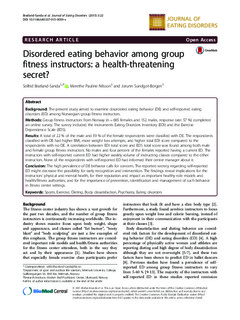| dc.contributor.author | Bratland-Sanda, Solfrid | |
| dc.contributor.author | Nilsson, Merethe Pauline | |
| dc.contributor.author | Sundgot-Borgen, Jorunn | |
| dc.date.accessioned | 2016-05-25T10:07:25Z | |
| dc.date.available | 2016-05-25T10:07:25Z | |
| dc.date.issued | 2015-06-24 | |
| dc.identifier.citation | Journal of Eating Disorders. 2015, 3, 22 | nb_NO |
| dc.identifier.uri | http://hdl.handle.net/11250/2390336 | |
| dc.description | Copyright
© Bratland-Sanda et al. 2015
This is an Open Access article distributed under the terms of the Creative Commons Attribution License (http://creativecommons.org/licenses/by/4.0), which permits unrestricted use, distribution, and reproduction in any medium, provided the original work is properly credited. The Creative Commons Public Domain Dedication waiver (http://creativecommons.org/publicdomain/zero/1.0/) applies to the data made available in this article, unless otherwise stated. | nb_NO |
| dc.description.abstract | Background:
The present study aimed to examine disordered eating behavior (DE) and self-reported eating disorders (ED) among Norwegian group fitness instructors.
Methods:
Group fitness instructors from Norway (n = 685 females and 152 males, response rate: 57 %) completed an online survey. The survey included the instruments Eating Disorders Inventory (EDI) and the Exercise Dependence Scale (EDS).
Results:
A total of 22 % of the male and 59 % of the female respondents were classified with DE. The respondents classified with DE had higher BMI, more weight loss attempts, and higher total EDI score compared to the respondents with no DE. A correlation between EDI total score and EDS total score was found among both male and female group fitness instructors. No males and four percent of the females reported having a current ED. The instructors with self-reported current ED had higher weekly volume of instructing classes compared to the other instructors. None of the respondents with self-reported ED had informed their center manager about it.
Conclusion:
The high prevalence of DE behavior calls for concern. The reported secrecy regarding self-reported ED might decrease the possibility for early recognition and intervention. The findings reveal implications for the instructors’ physical and mental health, for their reputation and impact as important healthy role models and health/fitness authorities, and for the importance of prevention, identification and management of such behavior in fitness center settings. | nb_NO |
| dc.language.iso | eng | nb_NO |
| dc.publisher | BioMed Central | nb_NO |
| dc.subject | sports | nb_NO |
| dc.subject | exercise | nb_NO |
| dc.subject | dieting | nb_NO |
| dc.subject | body dissatisfaction | nb_NO |
| dc.subject | psychiatry | nb_NO |
| dc.subject | eating disorders | nb_NO |
| dc.title | Disordered eating behavior among group fitness instructors: a health-threatening secret? | nb_NO |
| dc.type | Journal article | nb_NO |
| dc.type | Peer reviewed | nb_NO |
| dc.subject.nsi | VDP::Medical disciplines: 700 | nb_NO |
| dc.source.journal | Journal of Eating Disorders | nb_NO |
| dc.description.localcode | Seksjon for idrettsmedisinske fag / Department of Sports Medicine | nb_NO |
